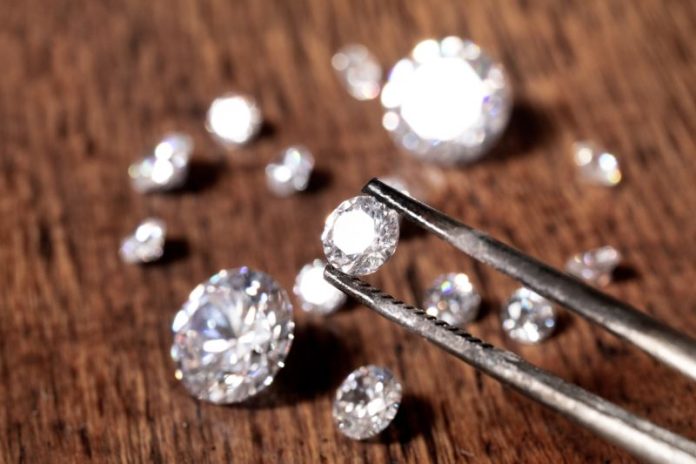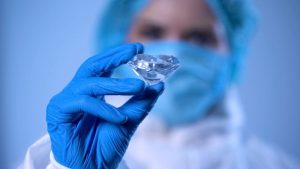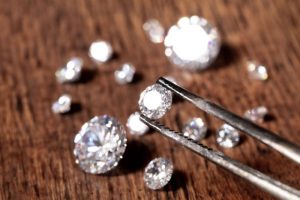
Lab-grown diamonds – also known as cultured or man-made diamonds – now account for more than 50 percent of the diamonds in the marketplace. This is because of changing market trends…
In the 1950s, Marilyn told women they were a girl’s best friend. By the 1970s, college girls judged their fiance’s affection by the amount of cash they spent to purchase their diamond engagement rings. But in the 1990s, tales of blood or conflict diamonds mined in African war zones and used to finance the activities of local warlords and organized crime-connected smugglers dimmed the sparkle of mined diamonds for those buyers who were unwilling to sacrifice their social justice convictions just to buy jewelry.
Science responded by perfecting a way to grow genuine diamonds in the lab.
Even so, the quest for lab-grown diamonds is not new.

Learning How Diamonds are Made
According to Amanda Butcher, author at the International Gem Society (IGS) website and Project Coordinator at The Energy Coalition, creating diamonds began in the 1700s when scientists discovered that diamonds consisted of pure carbon. “This started the race to create the first synthetic diamond,” she wrote for GIA.
According to geologyscience.com, those early scientists also discovered that diamonds are formed between 93 and 124 miles deep in the earth’s mantle where they are exposed to extreme pressure and temperature. They are made when geological plates containing carbon-rich crustal rocks and methane oxidation drop below one another in a process geologists call subduction. Carbon atoms within the materials bond together in a crystalline structure, forming diamond crystals.
The resulting diamond is a naturally occurring mineral made up of pure carbon atoms arranged in a crystalline lattice structure, and the process to create it takes millions, sometimes billions of years.
Lab-Grown Diamonds: First Attempts
Once diamonds became sought after commercially, mining companies began scouring remote locations to coax the mineral out of the earth mostly by open pit, underground and later extraction mining.
No matter which way it was accomplished, the process was time-consuming and expensive, so the quest to use carbon, temperature and pressure to “create” or culture real diamonds in the lab began.
The General Electric Company (GE) pioneered the effort in 1940 when it launched Project Superpressure specifically to make synthetic diamonds. The work was derailed by the Second World War, but throughout the 20th century, scientists fiddled with all manner of methods to produce diamonds from carbon.
According to the IGS, the research took another step forward, when a team of GE scientists made the first so-called synthetic diamonds in 1954. They used a high-pressure belt press to expose seed crystals to temperatures of 2,912°F and 100,000 atmospheric pressure (atm) and dissolved graphite – also composed of pure carbon – into meals including iron, nickel and cobalt to speed up the graphite’s transformation into a material that posted a 10 on the Mohs Scale of Hardness.
Even so, says the IGS, the “diamonds” they created were small and more suited to industrial use, but by 1971 the company’s scientists used a tube to expose the center of a graphite seed to heat and pressure until it “grew” a diamond.

Chemical Vapor Deposition
That high-pressure/high-temperature technique set the stage for further diamond-making processes including the chemical vapor deposition (CVD) method most manufacturers of lab-grown diamonds currently use.
That method places a diamond “seed” into a chamber where carbon gas is “heated” until the carbon sticks to the seed and grows a larger diamond.
That seed is generally another lab-grown diamond, according to Sally Magana, Ph.D., research scientist and manager of gemstone identification for the Gemological Institute of America (GIA), a California-based non-profit that sets standards that are used to evaluate gemstone quality through research, gem identification and diamond grading services.
“Most often the ‘seed’ is another laboratory-grown diamond as its properties can be carefully controlled,” Magana explains. “The quality of a laboratory-grown diamond is often a combination of the seed used and the specific growth recipe – both aspects are important in creating the final product.”
CVD gives scientists more control over the properties of lab-grown diamonds and makes possible the production of large, gem-quality diamonds, according to Butcher. “(Also) CVD can also take place at lower pressure and temperature, which makes the process much less costly.”
Lab-Grown Diamonds: Costly Production
But the process that turned laboratories into diamond-making sites was still not cheap. In fact, according to the IGS, it was not until the 1980s that laboratories were able to produce gem-quality stones and even longer to make the process pay off commercially. “Likely tens of thousands of dollars per stone,” Butcher says.
These days, the technology is more commercially affordable, she says.
Industry analysts report the cost to produce a single lab-grown diamond was $4,000 in 2008 and less than between $200 and $300 per stone now. “(With) the price falling every year as dozens of seed diamonds can undergo CVD at once,” Butcher says.

What’s the Difference?
Because they are identical to natural stones, telling the difference between the two is key, not just to consumers, but to gem market watchers as well.
According to Magana, the differences between natural and lab-grown diamonds are not apparent without specialized equipment. Even so lab-grown diamonds and natural diamonds have distinguishing characteristics because of their different growth conditions.
As a result, all lab-grown diamonds can be identified by a gemological laboratory and some laboratory-grown diamonds can be distinguished with screening devices available to those in the trade. That’s critical as lab-grown diamonds continue to capture a larger market share, Magana says.
“The prevalence of laboratory-grown diamonds within the market has increased the importance of having a diamond report from a reputable laboratory such as GIA that lists not only the diamond’s characteristics, including color and clarity but also whether the diamond is natural or laboratory-grown,” she says.
The GIA “grades” natural and lab-created diamonds according to a scale – known as the 4Cs – which ranks diamonds based on color, clarity, cut and carat weight. Its grading report specifically for laboratory-grown diamonds is a digital-only report that includes a full 4Cs assessment with a plotted clarity diagram, and an assessment of the growth method and post-growth treatment.
The lab-grown diamond’s girdle is laser inscribed with the term “Laboratory-Grown” and its GIA report number.
“We use the same nomenclature for the specifications of laboratory-grown diamonds as we use for the grades of natural diamonds,” Magana says.
Today’s Production
Currently, gem-quality lab-grown diamonds are made in facilities all over the globe including in the U.S. The majority of the laboratory-grown diamonds produced by the High Temperature, High Pressure (HPHT) method are manufactured in China, according to the 2021 Bain & Company Diamond Industry report on trends in that industry. Meanwhile, India produces more Chemical Vapor Deposition (CVD) grown diamonds than any other country, the report said.
“Additionally, many of these companies place a distinctive inscription on their stones so that the manufacturer can also be known,” Magana says.
Wherever they are made, lab-created diamonds continue to make inroads in the marketplace, and the quest to find new ways to make the stones continues.
The latest in that search involves technology that eliminates the need for a seed diamond and relies on normal atmospheric pressure and a liquid metal alloy system.
“This is a pioneering breakthrough,” says Rodney Ruoff Ph.D., leader of the team at the Institute for Basic Science in South Korea that developed the technology. “There are still intriguing avenues to explore.”
Sparkling Market Share
While scientists research cheaper, quicker ways to grow diamonds, the market for those man-made or cultured stones continues to sparkle. But as those stones become the darlings of consumers, some market watchers maintain that producers need to make sure that the quality of those continues to shine.
According to Mary Moses Kinney, chief merchandising officer for the Independent Jewelers Organization (IJO), a group that provides marketing and educational resources for its members, the market for lab-grown diamonds started gaining traction in the jewelry industry in 2017.
“When Lab-Grown Diamonds (LGD) first entered the market, the global market share was about one percent – today, it’s about 20 percent,” Moses Kinney says. “(And) LGD are gaining an increasing share of the global diamond market each year.”

Who’s Buying Lab-Grown Diamonds?
While some – mostly older buyers – continue to prefer natural or mined diamonds in their jewelry, Millenial and Gen-Z consumers are increasingly choosing lab-created stones when they purchase engagement rings, bracelets, pendants and other stone-studded necklaces.
That’s partly because man-made stones are disconnected from diamond mining-related controversies and can instead be traced to the lab in which they are grown.
For most though, it’s the price differential between lab-created and natural stones that appeals to those consumers.
“LGD are significantly less expensive than earth-mined diamonds, and the larger the diamond, the more substantial the savings,” Moses Kinney points out.
Even so, the price of jewelry containing lab-grown stones does fluctuate
“The price of LGD continues to fall as the market becomes more saturated – as such, the price differential is a moving target,” she says. “And LGD have little to no resale value.”
Still, Moses Kinney believes that LGD diamonds will never supplant natural ones in the marketplace.
“LGD are a choice and a viable one, but I do not see them overtaking the market,” she says.
In the meantime, Moses Kinney says lab-grown stone producers must keep a sharp eye on quality if they want to maintain and even increase their share of the diamond jewelry market.
“Initially, growers sought to create crystals of high purity that rivaled some of the finest natural diamonds then, in the last few years, as interest skyrocketed, aspirational players entered the market, many using subpar technology,” she says. “Not all LGD are created equal, and the LGD market needs regulation.”
This story about how lab-grown diamonds are made appeared in Rock & Gem magazine. Click here to subscribe. Story by Pat Raia.













